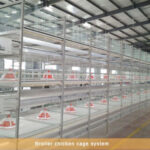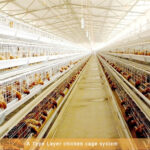How to prevent and control diseases when using broiler cages to raise chickens?
Now more and more farms use broiler cages. How to prevent and control diseases when using broiler cages to raise chickens?
Disinfection must always be placed in an important position. Three steps must be done, namely the disinfection of the chicks before they are placed in the house, during the entire breeding period, and after the chickens are sold. Before the chicks enter the house, the house should be strictly rinsed and the utensils should be disinfected (the house should be disinfected more than 3 times). There are three key points to master during the entire breeding period: a disinfection tank is set at the door of the chicken house, and the disinfection water is frequently replaced. Before feeding the chickens, change your work clothes and pay attention to the disinfection of hands and shoes. Always disinfect the inside and outside of the chicken house regularly. Generally twice a week in spring, increase the frequency of disinfection when chickens are sick. After the chickens are sold out, clean the chicken manure inside and outside the chicken house in time, and thoroughly wash the inside and outside of the chicken house. disinfect.

When using broiler cage equipment. Vaccination must be carried out in strict accordance with the immunization procedures suitable for the local epidemic. Correct vaccination must pay attention to the following issues: the vaccine species should be consistent with the age of the flock; various vaccination methods (mainly eye drops, nasal drops, injections, needles, etc.) have strict regulations and should be carried out according to the instructions: vaccine Generally use special thinner or distilled water for dilution. The diluted vaccine must be used up within the prescribed time. Every chicken should be vaccinated; pay attention to the storage of vaccines, eye drops, and nasal drops within 24 hours before and after immunization.
Viral diseases are prevented by vaccination, while most bacterial diseases rely on regular administration to achieve the purpose of prevention. Bacterial diseases and parasitic diseases prevalent in spring mainly include colibacillosis, salmonellosis, chronic respiratory diseases, coccidiosis, etc. The occurrence of these diseases is mostly related to age and environmental changes, which requires different conditions to be formulated according to different situations. Medication prevention program. For example, brooding chickens are prone to salmonellosis; chronic respiratory diseases and E. coli are prone to occur in winter and spring; coccidiosis mostly occurs at 15 to 60 days of age. To arrange the medication time correctly, we must first understand the diseases that are susceptible to infection at all ages and feeding stages, and timely medication can achieve the purpose of prevention.
If the disease is detected as early as possible, measures can be taken as soon as possible so as not to delay the best treatment opportunity. Early detection of disease can start from the following aspects: check the mental, activity and fecal status of the chickens every morning; observe the daily feed intake of the chickens.











